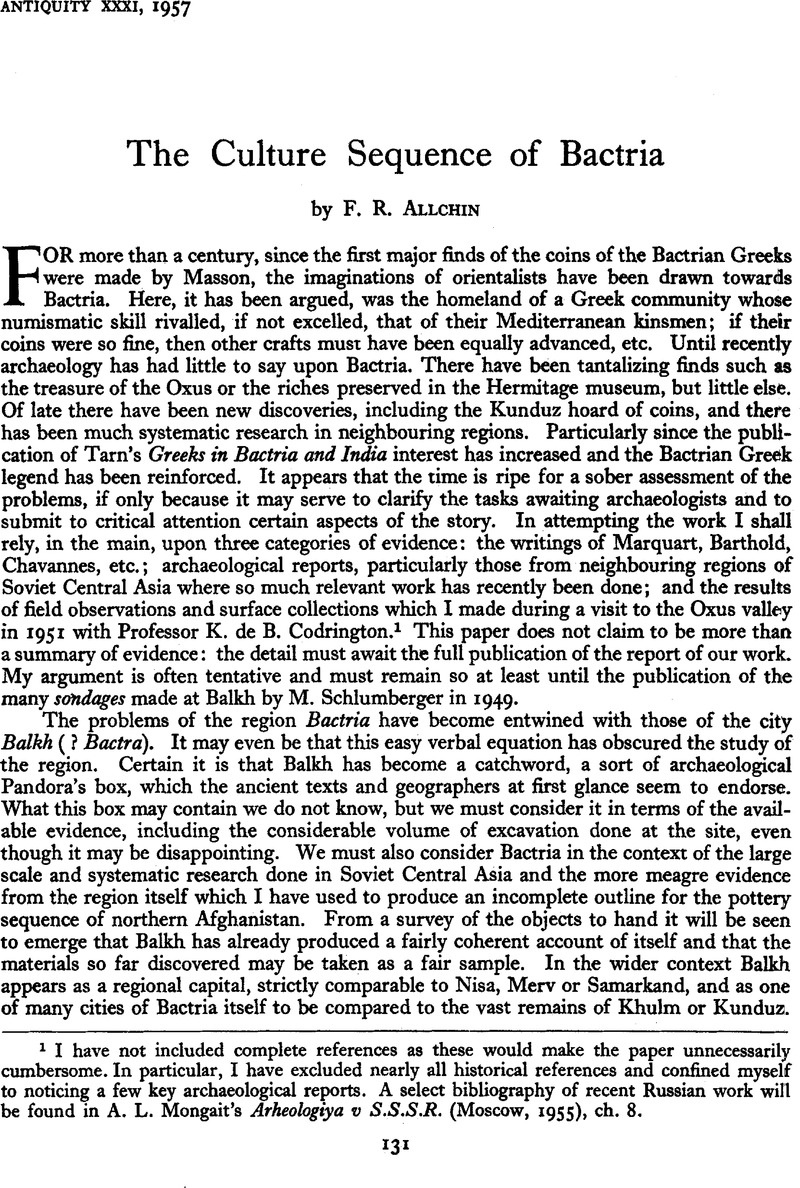No CrossRef data available.
Article contents
The Culture Sequence of Bactria
Published online by Cambridge University Press: 02 January 2015
Abstract

- Type
- Articles
- Information
- Copyright
- Copyright © Antiquity Publications Ltd 1957
References
1 I have not included complete references as these would make the paper unnecessarily cumbersome. In particular, I have excluded nearly all historical references and confined myself to noticing a few key archaeological reports. A select bibliography of recent Russian work will be found in A. L. Mongait’s Arheologiya v S.S.S.R. (Moscow, 1955), ch. 8.
2 P.P.S., 1953, P. 227.
3 C. Coon, ‘Excavation of the Kara Kamar Rock Shelter’, Afghanistan (1955), 1.
4 R. Ghirshman, Iran (London, 1954), p. 44.
5 A prime factor in the history of Central Asia is the utilization of water for irrigation. One of the basic factors of the rise of city life in the area was the draining of the river deltas and the shrinkage of the rivers towards their sources as more and more water was taken up for agricultural ends. Thus appeared the balance between town and country, which in extreme cases could starve the country to feed the city, and finally bring about the abandonment of the city. This process could be accelerated when war and devastation upset the balance and irrigation systems were destroyed.
6 For the culture sequence of Kobadian see particularly M. M. Diakonov, ‘Archaeological Researches on the Lower Course of the Kafirnigan River’, Materiali i Issledovaniya po Arheologii S.S.S.R., 37 (1953), p. 253 ff., and ‘Formation of a Class Society in Northern Bactria’, Sovyetskaya Arheohgiya, xix (1954), p. 121 ff.
7 W. B. Henning, Zoroaster Politician or Witchdoctor, Oxford, 1951.
8 ‘Le prospection archaeologique de Bactres’, Syria, XXVI (1949).
9 My reading of this vexed question and of the tangled history of the period mainly follows Codrington’s ‘Geographical Introduction to the History of Central Asia’, J.R.G.S., civ (1944). In any new study of the problems it will be necessary to take into account recent Soviet work, particularly, S. P. Tolstov’s Drevnii Khorezm (Moscow, 1948) and A. N. Bernshtam’s’ Historicoarchaeological studies in Central T’ien-shan and Pamir-Alay ‘, M.I.A.S., 26 (1952).
10 R. Ghirshman, Begram (1946).
11 J. Marquart, Ērānsāhr, p. 88.
12 R. Ghirshman, Les Chionites-Hephthalites (Paris, 1948).
13 ‘Mother of cities’, or as Barthold dryly, but correctly, has it ‘Mother of towns’, translates the Arabic vmm-al-bilad. The title is reminiscent of the almost synonymous Quranic umm-al-qurah which was applied to Mekka, and need imply no more than that the city was an administrative capital. The conceit of a 10th century geographer applying it to Balkh may be compared with the honorific ‘Ka’aba of sovereignty’ for Bukhara. Incidentally, the Muslims were impressed by the antiquity of Bukhara, for they coined the phrase ‘Old as Bukhara’.




